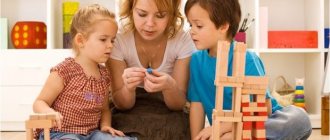The state of speech in children 4–5 years old can vary significantly. Some speak the language simply perfectly, others can only say something incomprehensible, pronouncing only a few words or making many mistakes in speech. In such cases, parents think about how to organize speech therapy classes for preschool children, what games and exercises will help them with speech development. After all, it is important to solve some problems before the child enters first grade.
Speech norms
You can understand how timely a child’s speech develops at this age based on the following guidelines.
- The main quality of speech of a 4–5 year old child is the ability to speak coherently and consistently.
- The child uses words in accordance with their meaning.
- His speech contains adjectives, pronouns, prepositions, including complex ones (due to, from under), adverbs.
- He knows how to control the strength and pace of his voice - speak softer, louder, whisper, slower, faster.
- Normal speech has the correct average tempo.
- A preschooler is able to fairly fully describe an object, toy, or picture.
- When telling a poem, the child actively uses intonation.
- Pronounces almost all sounds. Problems can only arise with [r] and [l], sometimes whistling and hissing ones continue to “sink”.
- The vocabulary at this age is approximately 3–4 thousand words, among which there are more and more adjectives denoting the qualities of objects, colors and shades; collective nouns appear.
- A child can begin to rhyme words, coming up with the most unimaginable constructions for rhyme (“fire” - a spark, “nikova” - no one’s).
- The baby is able to formulate sentences not only simple, but also complex (“I’m putting on a hat because it’s winter”; “I’m 4 years old, and my sister is already 7 years old”).
- Some grammatical errors are acceptable: incorrect agreement of words by gender and number, incorrect endings of verbs.
Diagnosis of speech development disorders in children 4–5 years old
There are several groups of speech disorders:
- Sound pronunciation defects. Articulates sounds incorrectly, replaces and omits them, swaps syllables in words;
- Lexical violations. Poor vocabulary, a 5-year-old child does not understand the meaning of words;
- Connectivity problems. Answers in monosyllables, there are no detailed answers, the narrative is illogical, the structure and grammatical order are broken;
- Melodic intonation defects. Does not control his voice, strength, timbre, pitch are impaired, the voice is inexpressive, monotonous, does not use interrogative and exclamation forms;
- Violation of tempo and rhythm. Speaks quickly or slowly, stammers, stops, speaks words syllable by syllable;
- Misunderstanding of spoken words. The most complex form of speech development disorder listed above.
If you suspect a delayed disorder in your child, do not waste time - show him to a neurologist and speech therapist. The sooner you start correctional work, the faster the child will “catch up” with the age norm for speech development. An excellent solution would be to enroll your child in a speech therapy group in kindergarten.
When there's a problem
Unfortunately, not all children can boast of this level of speech development. It is especially difficult for those whose parents do not pay due attention to this aspect: they communicate little with the child, read little, do not teach poetry with him, citing their endless busyness.
However, a child who by this age does not yet speak or speaks very poorly should definitely cause concern for the parents. In speech therapy, it is believed that this is the maximum permissible age for speech correction, when the time allotted for it is hopelessly running out. It is important to use it as much as possible to help your preschooler talk. After all, speech is not only a means of communication, but also the key to a little person’s successful education at school and his further socialization.
What should cause concern for parents at this age?
- If a child speaks very unintelligibly, changing, skipping or confusing letters and syllables, does not pronounce many sounds, it is difficult for those around him to understand.
- Answers in monosyllables, does not know how to construct a common sentence.
- Has difficulty describing pictures or toys, and cannot finish a sentence started by an adult.
- Has a very meager stock of words frequently used in everyday life.
- Has difficulty selecting and may confuse words, especially if they are similar in sound but have different meanings.
- “Eats” the endings of words, “swallows” syllables.
- Constantly gets confused in numbers, cases, prepositions, conjunctions, not responding to corrections from adults.
- Pronounces sounds inappropriately softly (lisps) or deliberately firmly (as if with an accent).
The reasons for such a delay can be very different: anomalies in the development of the tongue, palate, lips, hearing organs; neurological disorders, mental retardation, birth trauma or pregnancy pathologies, mental disorders, severe fear or psychological trauma, social neglect (lack of attention to the child, lack of communication and care, antisocial family).
Features of practicing hissing sounds
To teach a child to correctly pronounce hissing sounds, you must first introduce whistling sounds. If a child in the fourth year of life has learned to pronounce whistling sounds, then there should be no problems with hissing sounds. You can install them with a few simple exercises.
- "Naughty tongue." The child sticks the tip of his tongue out of his mouth. Then he lightly slaps it with his fingers, while saying: “five-five-five.”
- "Delicious jam." The lower lip is pulled down so that the teeth are visible. And the tip of the tongue licks the upper lip, as if it is very sweet there. At the same time, the lower jaw should remain motionless during the exercise.
- “Hide the candy.” Mouth closed. Tighten your tongue and touch your left, then your right cheek. It's like there's candy hiding behind your cheek.
Repeat exercises at least 5 times.
Note! Producing the sounds of native speech is very important for children. It will help them not only make contact with their peers, but also better master the preschool and school curriculum. Parents have the power to help their children avoid difficulties in the future and put the sounds correctly in time.
Let's go to the speech therapist
A child cannot cope with all these speech difficulties on his own. If you do not address them now, this can result in various types of speech retardation, such as delayed speech, psycho-speech development, and general speech underdevelopment. This, in turn, will lead to problems with learning at school. Therefore, timely assistance from a speech therapist for such disorders is mandatory.
A specialist will help the baby not only correct problems with sound production (lisp, lisp, burr), as many people think. A good speech therapist can do much more. The following aspects are within his competence:
- formation of correct speech;
- development of speech structure and vocabulary;
- development of attention, thinking, memory;
- mastering the basics of grammar.
In addition, classes with a speech therapist (if he is an experienced speech pathologist) can help with the following problems:
- stuttering;
- dysarthria;
- underdevelopment of speech with mental retardation;
- alalia;
- rhinolalia;
- dyslexia;
- dysgraphia, etc.
Select your speech therapist carefully. If he says that it will take a year of lessons 4 times a week to set the sound (the usual norm is 2 times), he does not give the child homework (they must be required), he constantly insists on classes to consolidate the sound (parents should do this on their own ), does not allow you to attend classes and at the same time demands a lot of money for your services - feel free to refuse such a “specialist” and look for another.
In what cases should you visit a specialist?
There are several signs that indicate your child's speech needs professional help:
- very poor vocabulary;
- inability to correctly pronounce a large number of sounds;
- incorrect choice of word, lack of correlation between the word and the object to which it refers;
- constant omission of some syllables in words;
- slow or, on the contrary, very fast speech, pronouncing most words in syllables;
- slurred speech, stuttering;
- constant hesitations and pauses.
In these cases, it is necessary to show the child to a speech therapist, possibly a neurologist, as quickly as possible, this will help identify the causes of the disorders and eliminate them.
How are classes going?
First, the specialist gets to know the parents and the baby, establishes contact with the child, and encourages him to communicate. And this is not always easy: some children are too reserved, others are shy or afraid of strangers, others are hyperactive and do not sit still.
Next, the specialist conducts speech therapy diagnostics:
- reveals the child’s ability to perceive information and understand the questions asked (estimates how long the child is looking for an answer);
- assesses vocabulary and gesture capabilities;
- assesses the degree of speech coherence, the number and types of speech errors;
- identifies problems with pronunciation - which groups of sounds are affected, in which parts of words they are pronounced defectively, etc.
Based on the information received, the speech therapist builds an individual plan for working with the child. Most often these are classes 2 times a week lasting from 30 to 45 minutes.
A good speech therapist allows and even welcomes the presence of parents in such classes, always comments on the progress achieved, constantly gives homework to consolidate acquired skills, showing parents what exercises and how to do them at home.
Classes for children 4 years old are conducted in the form of a game and include, if necessary, articulation and breathing exercises, logorhythmic exercises, exercises for producing sounds, the development of fine motor skills, speech breathing and phonemic hearing, and general speech development.
By the age of 5, such classes are no longer carried out only in the form of games - they prepare the child for the fact that he will soon have to sit in lessons at school and complete the teacher’s assignments. Therefore, they also include tasks for the development of intelligence.
Speech therapy games actively use all kinds of manuals (with pictures, coloring books, tasks for tracing a picture along the contour), bright thematic pictures, cards, children's lotto, cubes, pyramids, toys or objects that make sounds, children's musical instruments; weightless paper figurines of birds and butterflies; balls, plasticine, etc.
The most important tool in any speech therapist's arsenal is patience and praise.
At the same time, exercises related to articulation and production of sounds must be practiced in front of a mirror, so that the child can see the movements of the speech therapist, compare them with his own, and can visually control the correct execution.
Sets of articulatory gymnastics exercises for practicing basic movements of the tongue and lips
The tongue and lips play a huge role in clear and correct pronunciation. The ability to hold the organs of the speech apparatus in the desired position, and, therefore, correctly pronounce sounds, depends on their mobility, training and flexibility.
Complex for developing lip muscles
- "Smile". You need to stretch your lips into a smile and hold them in that position.
- "Bunny smile" The child can imagine that he is a bunny gnawing on a carrot with his front teeth. Then let the “bunny” smile so that all his teeth are visible. In this case, the upper jaw stands on the lower jaw, without overlapping it.
- "Tube". The lips are pulled forward in a tube, as if it were an elephant's trunk or a tube.
- "Bagel". The teeth are closed, the lips are rounded and extended forward. It is important that both the upper and lower incisors are visible.
- "Storm". You need to blow a strong stream of exhaled air through a tube into a glass of water. The result will be a “storm”.
- "Artist". Holding a pencil with your lips, you need to “draw” a circle or square in the air.
Complex for developing tongue muscles
- "Cup". You need to open your mouth wide, stick out your tongue as far as possible and bend it towards you so that it does not touch your teeth.
- "Shovel". Stick your completely relaxed tongue out of your mouth and hold it on your lower lip.
- "Sting". The tense tongue thrusts forward sharply, like a bee's sting.
- "Football". With your mouth closed, you need to rest your tongue alternately on the right and left cheeks, on the teeth, on the palate, etc.
- "Pendulum". Stick out your tongue and move your tense tongue right and left, like a clock pendulum.
- “Brushing our teeth.” With your mouth closed, you need to “brush” your upper and lower teeth.
- "Horse". Depict with your tongue how a horse clatters its hooves.
Complex for developing cheek muscles
- "Fed hamster." A mouthful of air is taken, the cheeks are puffed out and held in this position. You can inflate your right and left cheeks alternately.
- "Hungry Hamster" You need to pull your cheeks inward. At first, you can help the child with your hands.
- "Burst Balloon" The lips are tightly closed, the teeth are open. Puff out your cheeks. Then slap them with your palms.
- "Storm".
- Blowing soap bubbles
Sets of articulatory gymnastics exercises
Working out at home
In difficult cases, sessions with a speech therapist alone will not be enough. Parents will have to work with the child on their own. However, even with a more favorable prognosis, home exercises will only bring benefits. This includes consolidating the skills learned from a speech therapist, and completely at-home games if, for example, it was not possible to find a suitable speech therapist or the problem is not too serious.
Here are a few rules that will help parents properly organize speech therapy classes for children at home.
- Turn every activity into a game. If a child is interested, he learns the necessary skills unobtrusively and quickly.
- Increase the duration of classes gradually: starting from 5 minutes, gradually increasing to 20–35.
- Don't overload your child with information. 2-3 games at a time are quite enough for adequate assimilation of the material.
- Remember to praise. This is the best incentive for a baby.
- Play when the child is alert and in a good mood (after breakfast or lunchtime nap).
- Remember that your baby learns everything by imitating you. Therefore, always show him something by turning him face to face.
- If, when completing a task, you introduce your child to some natural phenomena, structure the work so that they relate to reality (we study snow and frost in winter, leaf fall in autumn).
Buy special literature to help you organize and conduct classes. For example, benefits N.E. Teremkova, T.Yu. Bardysheva, E.N. Monosova. These authors have various benefits for any age.
Pronunciation of complex sounds
Articulation develops gradually; children usually master the pronunciation of complex sounds last. Often in speech the child replaces them with simpler ones or does not pronounce them at all.
Sound "R"
Experts advise studying this difficult sound in a child at the age of 5. If the baby pronounces “r”, but incorrectly, then even earlier - then it’s more difficult to relearn.
To help:
- Tongue twisters with “r” (“Karl stole corals from Clara, and Clara stole Karl’s clarinet.”
- Imitation (just say “r” in your speech in front of the child as clearly and cleanly as possible).
- Production from other sounds that the child pronounces correctly. For example, when a child pronounces “zh”, carefully move the tongue deeper into the mouth with a stick - a “r” is formed. Strengthen the sound by repeating the exercise several times. Or the baby says “z”, lightly touching the alveoli with his tongue, and blows heavily on the tongue. The sound "r" is heard.
- Three-stage exercise: the tongue is “sucked” to the hard palate, the child takes a deep breath through the nose and a short exhale through the mouth, connecting the voice.
- Setting up mechanically (carried out only by a speech therapist - with a hammer, spatula).
Sound "Sh"
The production of this sound occurs at 3–5 years of age.
The most commonly used way is through “s”. The child raises his tongue to the sky, pronounces “s” and smoothly exhales air to make “sh”. Before directly placing the “w,” experts recommend developing articulation of the lips and tongue with the help of exercises:
- A wide smile, exposing both rows of teeth, for 5-7 seconds.
- Licking lips with a “wide tongue” from top to bottom.
- Curling the wide tip of the tongue towards the nose.
- The child stretches out his lips with a straw and blows on a cotton ball for a long time, pushing it, for example, into the corner of the table.
- The baby blows through his closed lips onto a strip of paper - stronger, weaker, stronger again.
What does a speech therapy session include?
During psychological and speech therapy classes for children 3-4 years old, the child’s education is simultaneously carried out not only in the speech sense, because the related processes of brain activity, speech functions, and motor skills in combination must be carried out in different directions:
- you need to develop general, fine motor skills (modeling, drawing, rolling, clapping, clenching and unclenching your fists, tapping your fingers, lacing, fastening and unfastening buttons will help here);
- It is equally important to develop articulatory motor skills (regular exercises for the muscles of the tongue, lips, larynx and palate);
- correction of sound pronunciation, correct production of sounds by a speech therapist;
- correction of errors in diction and training in rhythm, smoothness of speech and diction.
What are the benefits of speech therapy exercises?
The description of a speech therapy session for children 3-4 years old includes mandatory articulation gymnastics to relieve muscle tone and spasm, dynamic and static exercises for the tongue, corners of the lips, muscles of the lower jaw, cheeks, finger exercises and fine motor skills, sometimes reflexology massage. During corrective classes, children learn spatial concepts, develop motor skills and memory, visual images, attention, thinking and observation. Sensory functions develop, constructive thinking is practiced, and muscle tone is gradually normalized.
Psychological aspect of working with a child
Features of speech therapy classes with children 3-4 years old may relate to the psychological component; often children with speech impairments, due to contrasting themselves with those who speak well, become complex or withdraw into themselves. The teacher’s task is to win over the child, interest him and force him to overcome the barriers he himself has created regarding his own characteristics. The downside may be to oppose oneself in a conflicting manner, indiscipline, whims, and refusal to work together. In this case, individual speech therapist lessons are recommended for children 3-4 years old - it is easier to convince and interest a special child in private when an adult becomes the child’s friend and assistant, able to see the efforts behind the whims.






